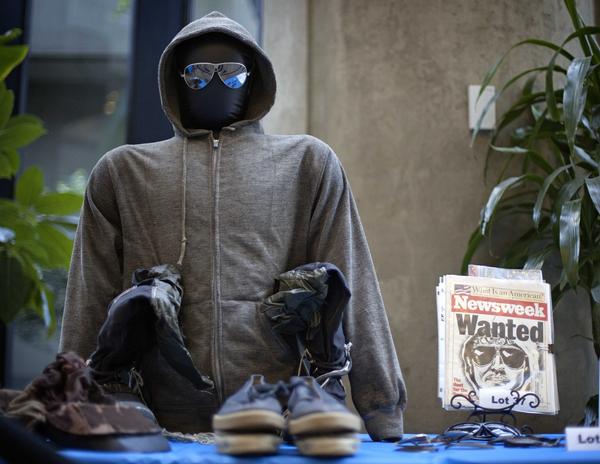Do you collect anything? My dear Aunt Isabel used to collect little spoons that she proudly displayed in a wall cabinet. Grandma collected teacups. I began a collection of beautiful hand bells. Well, some people collect items that are much more macabre — items that have a connection to notorious serial killers.
Videos By Rare
How macabre? Would you believe these collectors buy serial killers’ autographed photos, artwork and handwritten letters sent to people outside prison walls? Even an envelope bearing a handwritten return address commands a pretty penny. The murderer’s fingernail clippings, dirty socks or any other object that can be authenticated as genuine merit a place of honor on some people’s mantle. But those are not the most shocking serial killer items up for sale on the Internet.
Andy Kahan, the Houston Police Department’s victims’ rights advocate, has dedicated much of the last 15 years to following — and fighting — this bizarre form of commerce. Kahan told me he got interested in making sure serial killers could never profit from their crimes after reading an article about Arthur Shawcross, who sold paintings and poems out of his cell in upstate New York. This serial killer had sexually abused, mutilated and killed at least 14 people (including two children) in the ’70s and ’80s. Some Shawcross paintings sold for nearly $600.
“I thought to myself, ‘This is just not right,'” Kahan said. His research led him to eBay, where items from several notorious killers were being sold. Kahan vowed to spread the word about the morbid practice and actually bought up some of the most bizarre offerings to use during lectures on why there should be a law against the practice. He called these odd collectibles “Murderabilia,” and the name has stuck.
Kahan bought hair from Charlie Manson that had been fashioned into a swastika, dirt from a crawlspace tomb at John Wayne Gacy’s house and an action figure of cannibal killer Jeffrey Dahmer that is marketed with this little ditty: “Open me up for a sure delight and see what I ate for dinner last night.” Unzip the doll, and mock body parts fall out. Among the most disgusting thing for sale, according to Kahan, was a bag of rocks and dirt taken from the Texas road where in 1998 a black man named James Bryd was dragged to his death by three white supremacists.
“From a victims perspective, selling murderabilia is about the most nauseating and disgusting thing that could happen,” Kahan told me. “It is like being gutted all over again by the justice system.”
Kahan has made it his life’s calling to rid the Internet of this ugly profit-making booty. eBay finally gave in to his persistent calls and lobbying and has now banned the sale of murderabilia from its site. Kahan works hard to get states with the most serial killers in prison to pass “Notoriety for Profit” laws to make sure none of the money goes to the criminals. So far, Alabama, California, Florida, Michigan, Montana, New Jersey, Utah and Texas have done so.
Many people think the so-called Son of Sam laws prohibiting murderers from profiting by selling their life stories are still in effect, but they were declared an unconstitutional violation of free speech by the U.S. Supreme Court in 1991. The Notoriety for Profit laws are designed to follow the money, and therein lies the difference.
In the meantime, there are still grisly offerings out there: calendars, trading cards, T-shirts and even snow globes glorifying the grisly crimes of these killers. A handwritten recipe card from Dorothea Puentes for her tuna casserole is one of the coveted finds. Puentes ran a rooming house in Sacramento, Calif., in the ’80s and killed at least nine of the elderly boarders who dared to complain that she was cashing and keeping their Social Security checks. Then there are the gravestone chips from Wisconsin serial killer Ed Gein’s final resting place. His repulsive story was the inspiration for the movies “Psycho” and “Silence of the Lambs.”
After the purveyors of murderabilia found the eBay door closed, sellers simply started their own websites and their ghastly business flourishes. As Kahan says, “I have no problem with those who are collecting the stuff. My problem is someone profiting from it. It is blood money, plain and simple.”
While some of the convicts have entered into shady “trades” with sellers — mailing out their personal items in return for small gifts or money deposited into their prison accounts — many of the killers had no clue that what they were sending from prison was then being sold at auction sites.
“(David) Berkowitz had no idea his things were being sold and is violently opposed to it,” Dr. Scott Bonn told me. “After having been born-again in 1987 … he thinks it is a sacrilege.” As an author and professor of criminology, Bonn befriended the so-called Son of Sam killer as part of his research for an upcoming book called, “Why We Love Serial Killers.”
So why are we so fascinated by them? And what prompts people to collect these awful souvenirs? Bonn believes the media elevates these larger-than-life ghouls to morbid rock-star status. They become celebrity monsters.
“It’s an adrenalin rush, and we love to have the crap scared out of us,” Bonn said. “That, and we’re riveted to the dark side of humanity. … They define the outside parameters of what one human being can do to another.”
Indeed, but I still don’t want a bag of dirt from a crime scene on the shelf with my bells.
© CREATORS.COM

